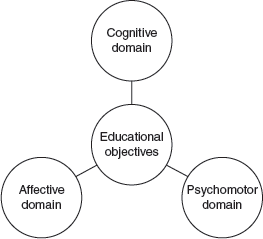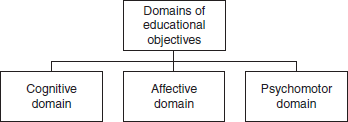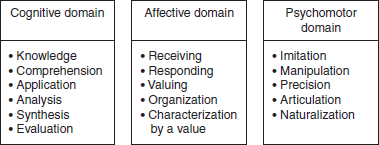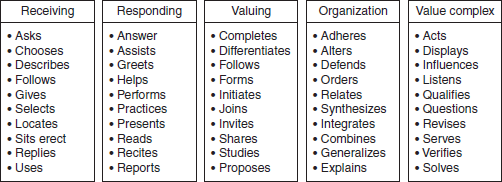2
Aims and Objectives of Teaching Science
CHAPTER OUTLINE
LEARNING OBJECTIVES
After reading this chapter, you will be able to:
Differentiate between the goals, the aims and the objectives
Classify the objectives into three domains—cognitive, affective and psychomotor
Comprehend Bloom's Taxonomy
Write down the objectives in behavioural terms
INTRODUCTION
Any activity becomes purposeful if it is carried out effectively. For effective implementation, planning the task is essential. Planning can be done on the basis of the goal, aims and the objectives of the activity.
Education is also an activity which brings about changes in an individual to develop his/her potentialities to the maximum. For this, various subjects are taught at the school level and science is one such subject. Before teaching science, we should know its goals and objectives and how the behaviour of students can be changed. Goals, aims and objectives are used inter-changeably, but they are different from each other (Figure 2.1).

Figure 2.1 Difference Between Goals, Aims and Objectives
Teaching of science is emphasized from the primary level itself. This is done on the basis of recommendations given by various commissions and committees. All of them suggested inclusion of science for:
- The development of basic skills of observation, classification, measurement, prediction, communication, etc.
- The development of special skills of investigation.
- The understanding of the relationship between science and society.
- Developing an innovative temper and creativity in students.
TAXONOMY OF EDUCATIONAL OBJECTIVES
For any lesson to be taught, a teacher decides the topic, prepares the objectives, uses a methodology and then evaluates the students. Different teachers frame different objectives to be achieved by them. As a result, there is a confusion among the teaching fraternity. To remove this confusion, the teachers can refer to the taxonomy of the educational objectives.
This concept of taxonomy in education was initiated in 1948 at a meeting of American Psychological Association in Boston. Certain principles were decided and an educational-logical-psychological classification system was followed. That is, educational consideration was the first priority. Secondly, logical inclusion of terms was done. Every term was defined precisely. Thirdly, the taxonomy was according to the relevant and accepted psychological principles.
After 1948, many meetings were held and in 1953, a threefold division of the educational objectives—cognitive, affective and psychomotor—was developed by Prof. P.S. Bloom and his associates. These three divisions were called domains (Figure 2.2).

Figure 2.2 Domains of Educational Objectives
Within each domain, learning objectives were arranged in a logical and psychological order. The major categories in each domain are being depicted in Figure 2.3.

Figure 2.3 Major Categories in Domains of Educational Objectives
I. Cognitive Domain (Knowledge and Intellectual Skill)
This domain represents the intellectual components of mental life and, thus, is very important with respect to education. Since in this domain, recall and recognition remain very active, every effort is made in science teaching to develop this aspect. This domain is further classified into 6 categories which are as follows (Figure 2.4):

Figure 2.4 Categories of Three Domains of Educational Objectives
- Knowledge
- Comprehension
- Application
- Analysis
- Synthesis
- Evaluation
- Knowledge: Knowledge is defined as the remembering of previously learned material. This may involve recalling a wide range of materials, forming specific facts to complete theories, but all that is required is bringing to the mind the appropriate information. Knowledge represents the lowest level of learning outcomes in the cognitive domain.
- Comprehension: Comprehension is defined as the ability to grasp the meaning of a material. This may be shown by translating the material from one form to another (words to number), by interpreting the material (explaining or summarizing), and by estimating the future trends (predicting consequences or effects). These learning outcomes go one step beyond the simple remembering of a material, and represent the lowest level of understanding.
- Application: Application refers to the ability to use the learned material in new and concrete situations. This may include the application of things such as rules, methods, concepts, principles, laws and theories. Learning outcomes in this area require a higher level of understanding than those under comprehension.
- Analysis: Analysis refers to the ability to break down a material into its component parts so that its organizational structure may be understood. This may include the identification of the parts, analysis of the relationships between parts, and the recognition of the organizational principles involved. Learning outcomes, here, represent a higher intellectual level than comprehension and application because they require an understanding of both the content and the structural form of the material.
- Synthesis: Synthesis refers to the ability to put the parts together to form a new whole. This may involve the production of a unique communication (theme or speech), a plan of operations (research proposal), or a set of abstract relations (scheme for classifying information). Learning outcomes in this area lay stress on creative behaviours, with major emphasis on the formulation of new patterns of structures.
- Evaluation: Evaluation is concerned with the ability to judge the value of a material (statement, research report) for a given purpose. The judgments are to be made on definite criteria which may be internal (organization) or external (relevance to the purpose). Learning outcomes, here, are the highest in the cognitive hierarchy as they have the elements of all the other categories and value judgment.
II. Affective Domain
It is concerned with the interests, emotions, mental tendencies and the values of the students. This domain is difficult to develop as interests, emotions, mental tendencies are individual conditions. It is the duty of the teacher to develop these domains. Further categories in affective domain are as follows (Figure 2.4):
- Receiving
- Responding
- Valuing
- Organization
- Characterization by a value or value complex
- Receiving: Receiving refers to a student's willingness to attend a particular phenomena or stimuli (classroom activities, textbook, music, etc). From a teaching standpoint, it is concerned with getting, holding and directing the student's attention. Learning outcomes in this area range from a simple awareness that a thing exists to a selective attention on the part of the learner. Receiving represents the lowest level of learning outcomes in the affective domain.
- Responding: Responding refers to an active participation on the part of the student. At this level, he not only attends a particular phenomenon, but also reacts to it in some way. Learning outcomes in this area may emphasize a readiness in responding (reads assigned material), willingness to respond (voluntarily reads beyond assignment) or satisfaction in responding (reads for pleasure or enjoyment). The higher levels of this category include those instructional objectives that are commonly classified under “interest”, that is, those that lay stress upon seeking out enjoyment in particular activities.
- Valuing: Valuing is concerned with the worth or value a student attaches to a particular object, phenomenon or behaviour. This ranges in degree from a more simple acceptance of a value (desires to improve groups skills) to a more complex level of commitment (assumes responsibility for the effective functioning of the group). Valuing is based on the internalization of a set of specified values, but clues to these values are expressed in the student's overt behavior. Learning outcomes in this area are concerned with the behavior that is consistent and stable enough to make the value clearly identifiable. The instructional objectives that are commonly classified under “attitudes” and “appreciation” would fall into this category.
- Organization: Organization is concerned with bringing together different values, resolving conflicts between them, and beginning the building of an internally consistent value system. Thus, the emphasis is on comparing, relating and synthesizing values. Learning outcomes may be concerned with the conceptualization of a value (recognizes the responsibility of each individual for improving human relations) or with the organization of a value system (develops a vocational plan that satisfies his need for both economic security and social service). The instructional objectives relating to the development of a philosophy of life would fall into this category.
- Characterization by a value or Value Complex: At this level of the affective domain, an individual has a value system that has controlled his behavior for sufficiently long time for him to have developed a characteristic “life style”. Thus, the behaviour is pervasive, consistent and predictable. Learning outcomes at this level cover a broad range of activities, but the major emphasis is on the fact that the behaviour is typical or characteristic of the student. The instructional objectives that are concerned with the student's general patterns of adjustment (personal, social, emotional) would be appropriate here.
III. Psychomotor Domain
This domain is concerned with the training of students’ physical activities and development of skills. Whatever physical work is done by an individual is a result of the neuro-muscular co-ordination. As the coordination level goes up, the actions become rapid and speedy. There are five categories in this domain (Figure 2.4):
- Imitation: It is the lowest level of psychomuscular activity. It initiates as an impulse and grows into an overt act. The performance of the act may also be repeated. This is the first skill for training the students for practical work and it is learnt by observing the teacher's performance.
- Manipulation: It involves a preference for some actions over the others. The directions are followed and then, the acts are performed by the students. Selection of an act is an important aspect.
- Precision: Precision is acquired by practice or repetition of a performance. It is related to the speed of an action as well as the ability to control an act.
- Articulation: It is the ability to handle many actions together and involves co-ordination in an action.
- Naturalization: The perfection attained by an individual in completing a task results in naturalization. After this, the actions of students become mechanical and are performed without any planning.
WRITING THE TEACHING OBJECTIVES IN BEHAVIOURAL TERMS
Till now, the classification of the educational or general objectives has been discussed. But, this classification does not indicate any way in which the learning of pupils can be measured. For their measurement, it is necessary to write them in such a way that they describe the change in the behaviour of the learner. Writing objectives in this manner is called as behavioural objectives. All the categories mentioned in Figure 2.4 can be described by using some action words or verbs. These words enable the teacher to evaluate whether learning has taken place or not. Since changes are brought in many aspects of pupil's behaviour, therefore, any teaching objective can be said to be meaningful when it defines completely that which behavioural change is being brought in a pupil. Thus, defining teaching objectives means that the teacher should write it in a simple language using certain specific words or action verbs. Action words corresponding to cognitive, affective and psychomotor domain are given in Figures 2.5, 2.6 and 2.7.

Figure 2.5 Action Verbs of the Categories in the Cognitive Domain

Figure 2.6 Action Verbs of the Categories in the Affective Domain

Figure 2.7 Action Verbs of the Categories in the Psychomotor Domain
On the basis of the action verbs mentioned above, here is a list of some specific objectives written in behavioural terms.
Behavioural Objectives in Cognitive Domain
- Recall terms, facts, principles, etc.
- Recognize facts, terms, concepts, principles, etc.
- Compare the related terms and concepts.
- Express the same fact in different ways.
- Classify objects, facts or any information.
- Indentify relationship.
- Formulate hypothesis on the basis of observations.
- Give reasons for happenings.
- Draw conclusions or inferences.
- Translate symbolic statements into verbal statements.
Behavioural Objectives in Affective Domain
- Show thrill and excitement while performing experiments.
- Read scientific literature with interest.
- Appreciate and acknowledge inter-dependence of organisms.
- Join scientific hobby club.
- Visit places of scientific interest.
- Feel satisfied in collecting and exhibiting the objects, specimens and pictures.
Behavioural Objectives in Psychomotor Domain
- Handle objects, instruments and specimens.
- Observe and record data.
- Measure weight, volume, temperature, etc.
- Draw and label the diagrams.
- Dissect neatly.
- Take precautions.
- Improvise apparatus and models.
THE IMPORTANCE AND NEED FOR WRITING THE OBJECTIVES IN BEHAVIOURAL TERMS
In the present scenario, writing the objectives in behavioural terms is important because:
- It specifies the teaching activity.
- It enables and helps the teacher to decide the teaching strategy.
- Teaching aids can be chosen according to the objective.
- Formulation of questions for tests and exams becomes easy.
- Evaluation of a student's performance can be done conveniently.
SUMMARY
- Planning of any activity is based on the aims and objectives of that activity.
- Before teaching science, we should know its goals and objectives and how the behaviour of students can be changed.
- Science is taught to develop the basic skills of investigation, observation, classification, measurement, prediction, etc.
- Science teachers, in earlier times, were indecisive about which objectives to include in their curriculum.
- Prof. P.S. Bloom gave the taxonomy of educational objectives on which the behavioural objectives of science teaching are framed.
- According to Bloom's Taxonomy, there are 3 domains of educational objectives—cognitive, affective and psychomotor.
- The cognitive domain has 6 categories—knowledge, comprehension, application, analysis, synthesis and evaluation.
- The affective domain has 5 categories—receiving, responding, valuing, organization and characterization by a value.
- The psychomotor domain includes 5 categories—imitation, manipulation, precision, articulation and naturalization.
- There are action verbs corresponding to each domain which help in the formulation of behavioural objectives.
QUESTIONS
- What is the difference between aims and objectives?
- Why is the teaching of science necessary?
- What are the three domains of educational objectives?
- Exemplify the various categories of cognitive domain.
- Discuss the categories of affective domain.
- What is the importance of psychomotor domain?
- Why should we write objectives in behavioural terms?
